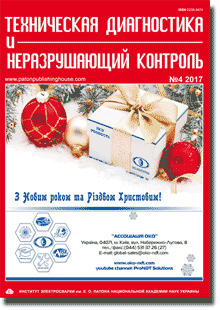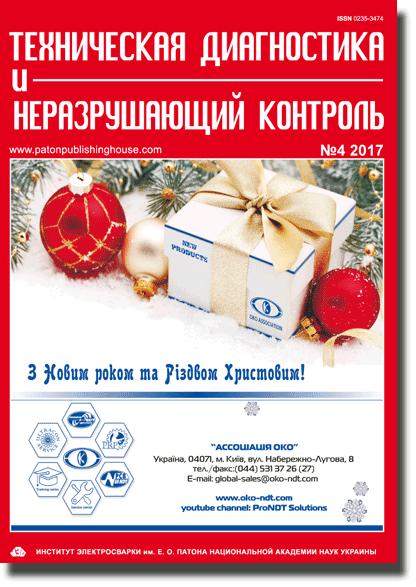| 2017 №04 (01) |
DOI of Article 10.15407/tdnk2017.04.02 |
2017 №04 (03) |

Technical Diagnostics and Non-Destructive Testing, №4, 2017 pp. 7-13
Methodology of numerical prediction of serviceability of pipeline elements with corrosion-erosion defects under conditions of high-temperature operation
A. S. Milenin, E. A. Velikovanenko, G. Ph. Rozynka, N.I. Pivtorak
E.O. Paton Electric Welding Institute of the NASU, 11 Kazimir Malevich str., 03150, Kiev, Ukraine. E-mail: office@paton.kiev.ua
A complex of models of numerical prediction of subcritical damage and limiting state of welded pipeline elements under conditions of high-temperature operation, taking into account the features of site welding and the presence of an isolated defect of local wall thinning of the corrosion-erosive nature, was developed. The characteristics of current and limited state of welded structures under the conditions of propagated creep deformations were investigated using the example of a characteristic pipeline of stainless steel. The influence of a local wall thinning defect of a pipeline element on the regularities of subcritical and macroscopic metal damage was shown at a complex temperature-force action. 11 – Ref., 7 – Fig.
Keywords: subcritical damage, creep deformations, pipeline element, wall thinning defect, limited state, numerical prediction
Reference
- Jelwan, J., Chowdhury, M., Pearce, G. (2013) Design for creep: A critical examination of some methods. Engineering Failure Analysis, 27, 350-372. https://doi.org/10.1016/j.engfailanal.2012.08.022
- Xue, J.-L., Zhou, C.Y., Peng, J. (2015) Ultimate creep load and safety assessment of P91 steel pipe with local wall thinning at high temperature. Int. J. of Mechanical Sci., 93, 136-153.
- Nedoseka, A.Ya., Nedoseka, S.A., Smogol, Yu.A. et al. (2014) Long-term strength of materials operating at high temperatures by acoustic emission data. Tekhn. Diagnost. i Nerazrush. Kontrol, 4, 17-21 [in Russian].
- Wei, Y., Zhang, L., Au, F.T.K. et al. (2016) Thermal creep and relaxation of prestressing steel. Construction and Building Materials, 128, 118-127. https://doi.org/10.1016/j.conbuildmat.2016.10.068
- Lemaitre, J., Desmorat, R. (2005) Engineering damage mechanics. Ductile, creep, fatigue and brittle failures. Berlin, Springer-Verlag.
- Makhnenko, V.I. (2006) Safe operating life of welded joints and assemblies of modern structures. Kiev, Naukova Dumka [in Russian].
- Xue, L. (2008) Constitutive modeling of void shearing effect in ductile fracture of porous materials. Engineering Fracture Mechanics, 75, 3343-3366. https://doi.org/10.1016/j.engfracmech.2007.07.022
- Velikoivanenko E.A., Rozynka G.F., Milenin A.S. and Pivtorak N.I. (2015) Evaluation of operability of the main pipeline with local wall thinning at repair by arc surfacing. The Paton Welding J., 1, 18-23. https://doi.org/10.15407/tpwj2015.01.03
- Karzov, G.P., Margolin, B.Z., Shvetsova, V.A. (1993) Physical-mechanical modeling of fracture processes. Saint-Petersburg, Politekhnika [in Russian].
- Velikoivanenko, E.A., Rozynka, G.F., Milenin, A.S. et al. (2013) Modelling of processes of nucleation and development of ductile fracture pores in welded structures. The Paton Welding J., 9, 24-29.
- (1967) Physical properties of steels and alloys applied in power engineering. Ed. by B.E.Nejmarka. In: Refer.book. Moscow-Leningrad, Energiya [in Russian].
The cost of subscription/purchase order journals or individual articles
| Journal/Currency | Annual Set | 1 issue printed |
1 issue |
one article |
| TPWJ/USD | 384 $ | 32 $ | 26 $ | 13 $ |
| TPWJ/EUR | 348 € | 29 € | 24 € | 12 € |
| TPWJ/UAH | 7200 UAH | 600 UAH | 600 UAH | 280 UAH |
| AS/UAH | 1800 UAH | 300 UAH | 300 UAH | 150 UAH |
| AS/USD | 192 $ | 32 $ | 26 $ | 13 $ |
| AS/EUR | 180 € | 30 € | 25 € | 12 € |
| SEM/UAH | 1200 UAH | 300 UAH | 300 UAH | 150 UAH |
| SEM/USD | 128 $ | 32 $ | 26 $ | 13 $ |
| SEM/EUR | 120 € | 30 € | 25 € | 12 € |
| TDNK/UAH | 1200 UAH | 300 UAH | 300 UAH | 150 UAH |
| TDNK/USD | 128 $ | 32 $ | 26 $ | 13 $ |
| TDNK/EUR | 120 € | 30 € | 25 € | 15 € |
AS = «Automatic Welding» - 6 issues per year;
TPWJ = «PATON WELDING JOURNAL» - 12 issues per year;
SEM = «Electrometallurgy Today» - 4 issues per year;
TDNK = «Technical Diagnostics and Non-Destructive Testing» - 4 issues per year.





